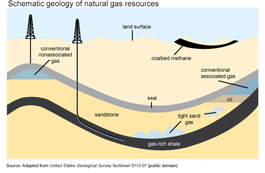The United States now produces nearly all of the natural gas that it uses
U.S. natural gas production in 2017 was the second-highest level recorded. Most of the production increases since 2005 were the result of horizontal drilling and hydraulic fracturing techniques, notably in shale, sandstone, carbonate, and other tight geologic formations. Natural gas is produced from onshore and offshore natural gas and oil wells and from coal beds. In 2017, U.S. dry natural gas production was slightly greater than U.S. natural gas consumption.
Five states accounted for about 65% of total U.S. dry natural gas production in 2017. The top five natural gas-producing states and their share of total U.S. natural gas production in 2017
- Texas—23%
- Pennsylvania—20%
- Oklahoma—8%
- Louisiana—8%
- Ohio—6%
About 4% of U.S. dry natural gas was produced offshore in the Federal Gulf of Mexico in 2017.

Source: U.S. Energy Information Administration, Annual Energy Outlook 2016 Reference case, September 2016
What is shale?
Shale is a fine-grained sedimentary rock that forms when silt and clay-size mineral particles are compacted, and it is easily broken into thin, parallel layers. Black shale contains organic material that can generate oil and natural gas, which is trapped within the rock's pores.
Where are shale gas resources found?
Shale natural gas resources are found in shale formations that contain significant accumulations of natural gas and/or oil. These resources, or plays, are found in about 30 states. The Barnett Shale in Texas has been producing natural gas for more than a decade. Information gained from developing the Barnett Shale provided the initial technology template for developing other shale plays in the United States.
Shale gas and tight gas
The oil and natural gas industry generally distinguishes between two categories of low-permeability formations that produce natural gas:
- Shale natural gas
- Tight natural gas
Shale natural gas
Large-scale natural gas production from shale began around 2000, when shale gas production became a commercial reality in the Barnett Shale located in north-central Texas. The production of Barnett Shale natural gas was pioneered by the Mitchell Energy and Development Corporation. During the 1980s and 1990s, Mitchell Energy experimented with alternative methods of hydraulically fracturing the Barnett Shale. By 2000, the company had developed a hydraulic fracturing technique that produced commercial volumes of shale gas. As the commercial success of the Barnett Shale became apparent, other companies started drilling wells in this formation, and by 2005, the Barnett Shale was producing almost half a trillion cubic feet (Tcf) of natural gas per year. As natural gas producers gained confidence in their abilities to profitably produce natural gas in the Barnett Shale and saw confirmed results in the Fayetteville Shale in northern Arkansas, producers started developing other shale formations. These new formations included the Haynesville in eastern Texas and north Louisiana, the Woodford in Oklahoma, the Eagle Ford in southern Texas, and the Marcellus and Utica shales in northern Appalachia.








